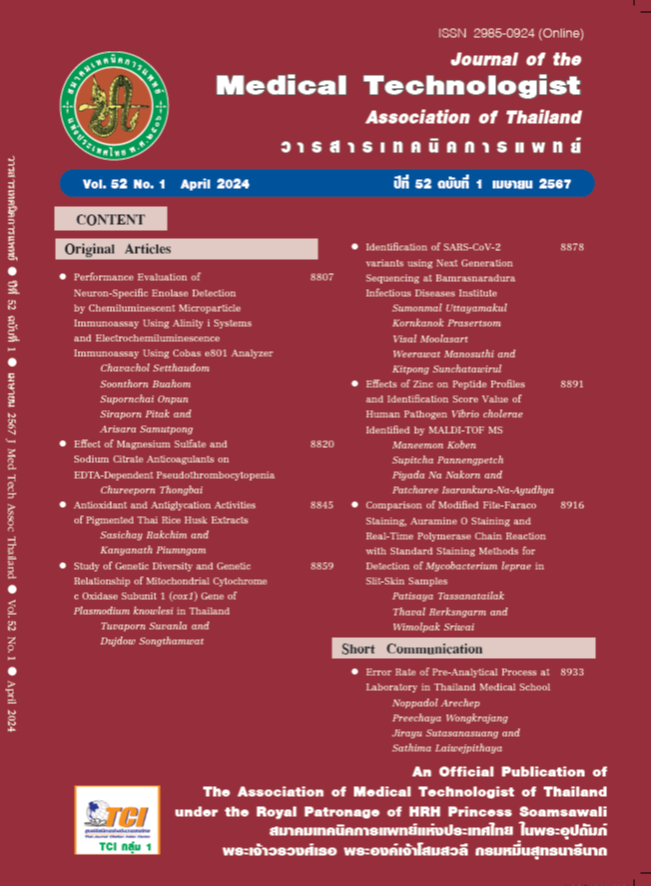ฤทธิ์การยับยั้งอนุมูลอิสระและการต้านไกลเคชันของสารสกัดจากแกลบข้าวไทยที่มีรงควัตถุ
คำสำคัญ:
ต้านอนุมูลอิสระ, ต้านไกลเคชั่น, โรคเบาหวาน, แกลบข้าวไทยที่มีรงควัตถุ, แอนโทไซยานินบทคัดย่อ
โรคเบาหวานเป็นโรคไม่ติดต่อเรื้อรังซึ่งเป็นสาเหตุอันดับต้นในการเสียชีวิตของคนทั่วโลก น้ำตาลในเลือดที่สูงจะเหนี่ยวนำให้เกิดปฏิกิริยาไกลเคชันระหว่างน้ำตาลกับโปรตีนทั้งภายในและภายนอก เซลล์จนทำ ให้เกิดสาร advanced glycosylation end products (AGEs) ทำ ให้ความยืดหยุ่นของหลอดเลือดลดลง และเกิดออกซิเดชันในเซลล์มากขึ้น ปัจจุบันเริ่มมีการศึกษาการใช้ข้าวซึ่งเป็นพืชเศรษฐกิจที่สำคัญของไทยในการรักษาโรคเบาหวานอย่างกว้างขวางขึ้น แต่การศึกษาในส่วนของแกลบข้าวยังมีไม่มาก งานวิจัยนี้จึงได้ศึกษาฤทธิ์การยับยั้งอนุมูลอิสระด้วยวิธี DPPH assay และฤทธิ์ต้านการเกิดไกลเคชันด้วยวิธี In-vitro BSA-glucose assay ในสารสกัดหยาบจากแกลบข้าวไทยที่มีรงควัตถุ 4 ชนิดคือ ข้าวหอมมะลิ ข้าวสังข์หยด ข้าวไรซ์เบอร์รี และข้าวเหนียวดำ โดยเปรียบเทียบผลจากการสกัดด้วย 2 วิธี คือ สกัดด้วยสารละลายเอทานอลเข้มข้นร้อยละ 70 และสกัดด้วยการต้มในน้ำพบว่า การสกัดด้วยเอทานอลมีฤทธิ์ยับยั้งอนุมูลอิสระและฤทธิ์ต้านการเกิดไกลเคชันได้ดีกว่าการต้มอย่างมีนัยสำคัญ (p < 0.05) โดยสารสกัดจากแกลบข้าวเหนียวดำ มีฤทธิ์ยับยั้งอนุมูลอิสระดีที่สุด มีค่า IC50 = 139.76 ± 52.07 ไมโครกรัมต่อมิลลิลิตรซึ่งมีฤทธิ์ดีกว่าสารมาตรฐานบิวทิเลเตทไฮดรอกซีโทลูอีน (BHT) (IC50 = 161.38 ± 33.75 ไมโครกรัมต่อมิลลิลิตร) และมีฤทธิ์ต้านการเกิดไกลเคชันดีที่สุด มีค่า IC50 = 234.69 ± 29.02 ไมโครกรัมต่อมิลลิลิตร ซึ่งมีฤทธิ์ดีกว่าอะมิโนกัวนิดีน (AG) ที่ใช้เป็นสารต้านไกลเคชัน (IC50 = 430.23 ± 6.03 ไมโครกรัมต่อมิลลิลิตร) สอดคล้องกับปริมาณสารประกอบฟีนอลิกรวม (60.60 ± 3.57 มิลลิกรัม gallic acid equivalent (GAE) ต่อกรัม) และปริมาณแอนโทไซยานินรวม (2.064 ± 0.2 มิลลิกรัมต่อลิตร) ที่พบสูงสุดในสารสกัดจากแกลบข้าวเหนียวดำ ผลการศึกษาดังกล่าวอาจเป็นแนวทางในการนำไปพัฒนา เป็นยาและอาหารเสริมสำ หรับผู้ป่วยโรคเบาหวาน
เอกสารอ้างอิง
International Diabetes Federation. IDF Diabetes Atlas, 10th ed. Brussels, Belgium: International Diabetes Federation; 2021.
Wacharapat P. Changes of pulpal and periapical tissue in a patient with diabetes mellitus. Songklanakarin Dent J 2014; 2: 20-37. (in Thai)
Asmat U, Abad K, Ismail K. Diabetes mellitus and oxidative stress-A concise review. Saudi Pharm J 2016; 24: 547-53.
Thai Rice Exporters Association. Report on rice export situation Trends and direction of rice exports in 2019 [cited 2020 Jan 2]. Available from: http://www.thai- riceexporters.or.th/Press%20release/2019/ TREA%20Press%20Release%20Thai%20 Rice%20Situation%20&%20Trend%20 Year%202019-30012019.pdf.
Semsang N, Keawlangkar N, Chanthachai W. Antioxidant capacities and phenolic compounds of the husk, bran and endosperm of Thai rice [cited 2020 Jan 13]. Available from: http://www.research. cmru.ac.th/research59/ris/download. php?download_file=article&no=545
Butsat S, Siriamornpun S. Antioxidant capacities and phenolic compounds of the husk, bran and endosperm of Thai rice. Food Chem 2010; 119: 606-13.
Wisetkomolmat J, Arjin C, Hongsibsong S, et al. Antioxidant activities and characterization of polyphenols from selected northern Thai rice husks: relation with seed attributes. Rice Sci 2023; 30: 148-59.
Petchlert C, Sangprathum T. Comparison of phenolic and anthocyanin content among four differences of raw and cooked rice. Naresaun Phayao J 2020; 13: 36-41. (in Thai)
Shao-Hua Huang, Lean-Teik Ng. Quantification of polyphenolic content and bioactive constituents of some commercial rice varieties in Taiwan. J Food Compos Anal 2012; 26: 122-7.
Daiponmak W, Senakun C, Siriamornpun S. Antiglycation capacity and antioxidant activities of different pigmented Thai rice. Int J Food Sci 2014; 49: 1805-10.
Blois MS. Antioxidant determinations by the use of a stable free radical. Nature 1958; 29: 1199-200.
Chan SW, Lee CY, Yap CF, Wan Alda WM, Ho CW. Optimisation of extraction conditions for phenolic compounds from limau purut (Citrus hystrix) peels. Int Food Res J 2009; 16: 203-13.
Lee J, Durst RW, Wrolstad RE, et al. Determination of total monomeric anthocyanin pigment content of fruit juices, beverages, natural colorants, and wines by the pH differential method: collaborative study. J AOAC Int 2005; 88: 1269-78.
Piumngam K. In vitro study of antioxidant, anti-glycation and anti-inflammatory effect of Thai medicinal plants for Diabetic Patients. J Med Tech Assoc Thailand 2020; 48: 7504-18. (in Thai)
Ford L, Theodoridou K, Sheldrake G, Walsh P. A critical review of analytical methods used for the chemical characterisation and quantification of phlorotan- nin compounds in brown seaweeds. Phytochem Anal 2019; 30: 587-99.
Radoslaw P, Henryk Z, Danuta C, Krzysz- tof G. Antioxidant activity of ethanolic and aqueous extracts of Uncaria tomentosa (Willd.) DC. J Ethnopharmacol 2006; 104: 18-23.
Mustarichie R, Runadi D, Ramdhani D. The antioxidant activity and phytochemical screening of ethanol extract, fractions of water, ethyl acetate and n-hexane from mistletoe tea (Scurrula atropurpureabl. dans). Asian J Pharm Clin Res 2017; 10: 343-7.
Pietta PG. Flavonoids as antioxidants. J Nat Prod 2000; 63: 1035-42.
Wan-Ju Y, Shih-Min H, Wei-Hwa L, Chi- Hao W. Polyphenols with antiglycation activity and mechanisms of action: A review of recent findings. J Food Drug Anal 2017; 25: 84-92.
ดาวน์โหลด
เผยแพร่แล้ว
รูปแบบการอ้างอิง
ฉบับ
ประเภทบทความ
สัญญาอนุญาต
ลิขสิทธิ์ (c) 2024 วารสารเทคนิคการแพทย์

อนุญาตภายใต้เงื่อนไข Creative Commons Attribution-NonCommercial-NoDerivatives 4.0 International License.






